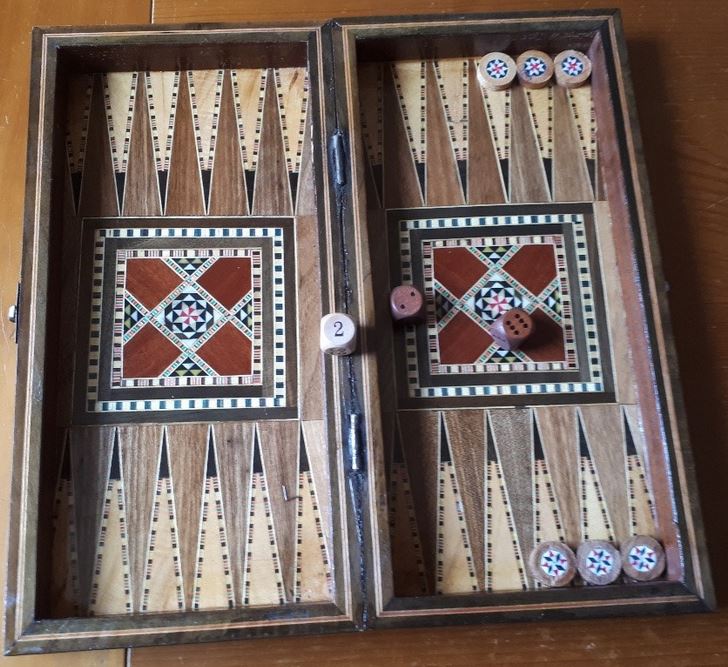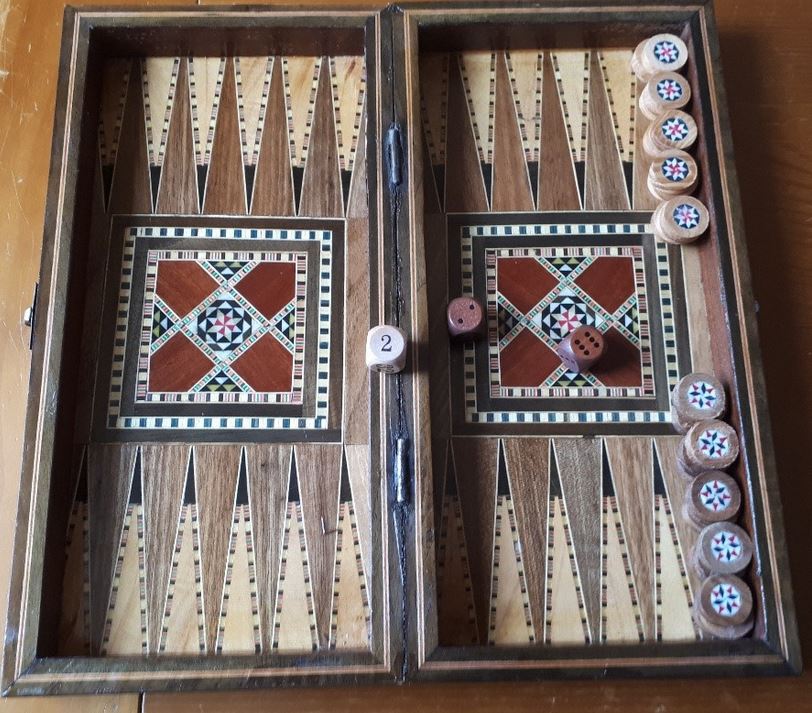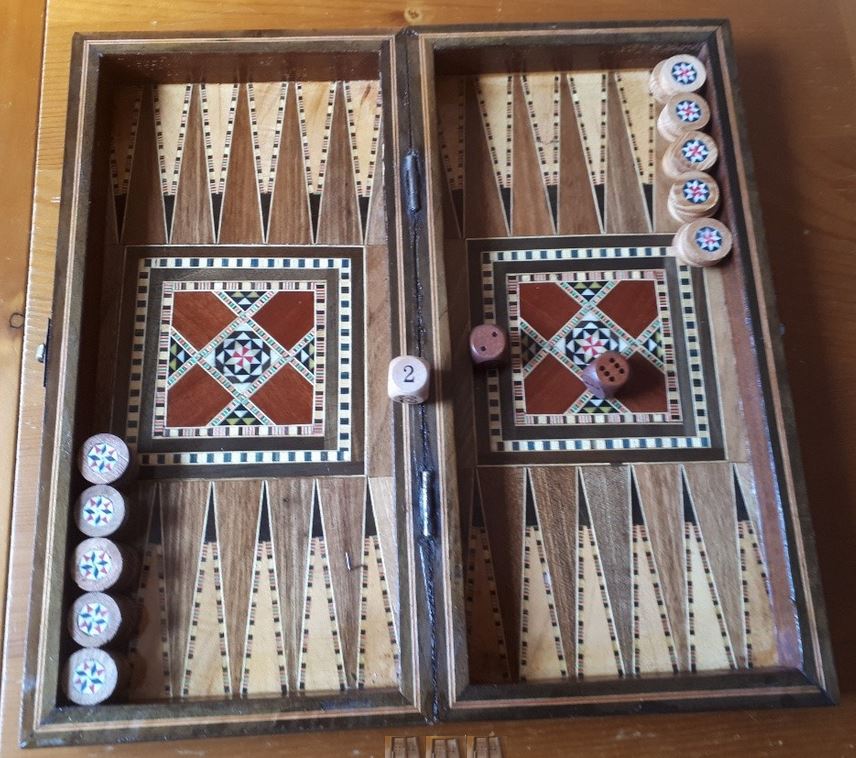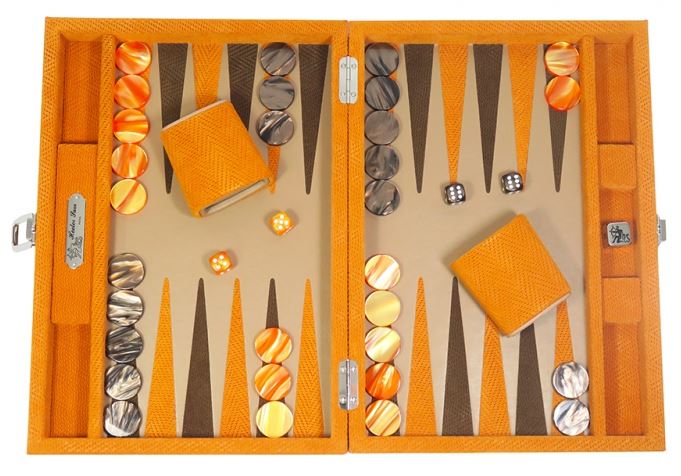Last updated on July 13, 2024
The game of backgammon has been around for about five thousand years. During that time there have been a number of backgammon variants. In today’s Deluxe Backgammon post, we will take a look at some of those variations. Not all of these variations are still played, but there should be enough information below for you to try one of these variants on your quality backgammon set.
Acey-deucy
Acey-deucey is a variant of backgammon. It has been a favourite pastime of the US Navy, Marine Corps and Merchant Marines since WW1. It differs from normal backgammon in several ways. Firstly, all of the checkers start the game off the board and are entered as if they were on the bar. Once a piece has been entered, it can be moved even though other pieces are off the board. A common strategy is to leave one piece off the board so that it can be used for defensive purposes. There is no conclusive set of rules for this game, with many variations to the rules.
A player who rolls doubles may move a total of four times, each move traversing as many spaces as the rolled amount (two fives rolled result in four moves of five points each). After rolling these doubles, the player takes another turn.
If a player rolls an acey-deucey (a 1 and a 2), they play the 1 and the 2. Then they choose any number from 1 to 6 and move as if they had just thrown a double. Then that player takes another turn.
After the opening phase, gameplay continues in a similar fashion to modern backgammon. However, there are several notable differences to modern backgammon:
- After rolling and playing doubles or acey-deucey (1-2), the player must roll and move again.
- A roll of acey-deucey (1-2) is played and then the player chooses a double of their choice.
- After rolling a double, the player moves and then rolls again for another turn.
- Upon reaching the home board, a piece may not be moved again until all others have arrived.
- An exact roll is required to bear off.
- A player can move pieces even if he has pieces on the bar.
Hypergammon
Hypergammon differs from normal backgammon in several ways. Firstly, each player only uses three checkers rather than the normal fifteen. These three checkers start on the 22nd, 23rd and 24th points. Apart from the setup and number of checkers in play the rules are the same as standard backgammon.
Hypergammon is generally quicker in terms of game time because there are fewer checkers in play. However, it does have some interesting characteristics. The difficulty of getting two pieces on the same point means that both players nearly always have blots on the board. This means that it is nearly impossible to protect blots to prevent them from being sent to the bar. The lead can also change hands very quickly as a large double will allow you to advance all of your checkers with a single roll.
Plakotó
Plakotó is a popular tables game played in Greece. It is usually played alongside two other Greek backgammon variants, Févga and Pórtes. The three games together are called Tavli and are generally played sequentially. Just like standard backgammon, both players start with fifteen checkers, however, all of the checkers begin on the 24-point.
There are a couple of key differences between Plakotó and standard backgammon. At the start of a match, both players roll one die and the higher number goes first. The winning player then rolls the two dice again to begin their first turn. In subsequent first games, the winner of the previous game goes first.
Hitting is not allowed in the game of Plakotó. Instead, if a player lands on a point occupied by an opponent’s single checker, the opponent cannot move his checker unless the player moves his checker. In other words, the opponent’s checker is pinned and cannot move. A block is created by two checkers of a player lying on a point or one of his checkers pinning the opponent’s checker.
The mother checker is the last checker on a player’s starting point. It is crucial in the game of Plakotó because if the mother checker gets pinned by an opponent’s checker before it has left the starting point, the game is over and two points are lost. This particular rule has an exception if the opponent has his own mother checker at the starting point. A game in which the mother checkers of both players are pinned results in a tie.
Févga
Févga is one of three Greek tables games called Tavli. The other two are Pórtes and Plakotó. Generally, each of these games would be played as part of a match. The setup for Févga is different from standard backgammon because all fifteen checkers start on a single point on diagonally opposite points of the board. At the start of a match, both players roll one die and the higher number goes first.
The winning player then rolls the two dice again to begin their first turn. In subsequent first games, the winner of the previous game goes first. There is no hitting in Févga because a single checker by itself controls a point, and an opposing checker cannot land there. Additionally, you are not allowed to block all six points in your opponent’s home board.
If you have built a six prime and your opponent has moved all of their checkers onto the one point behind your prime, then you must unblock a point in your prime to allow them the chance to move.
Pórtes
Pórtes is another Greek table game under the group name of Tavli. The other two are Févga and Plakotó. Pórtes is virtually identical to standard backgammon, but with a few minor differences in the rules. The winner of the opening roll will reroll for their first turn.
The winner of a game scores one point for a normal win and two points for a gammon. There is no backgammon. Finally, there is no doubling cube in Pórtes. A regular player of standard backgammon will easily adapt to these minor changes.
Old English Backgammon
Old English backgammon was very popular in England prior to the 1970s. This version is no longer commonly played as online play has forced players to adhere to the accepted rules of standard backgammon.
The setup for Old English backgammon is exactly the same as the standard game. There are three key differences from the normal game. First, you may have a maximum of five checkers on a single point. Additionally, you are allowed to play the dice rolls in such a way that only a single roll can be played. Lastly, the doubling cube is traditionally not played.
Tavla
Backgammon is known as Tavla in Turkey. The game is played with a fast pace and plenty of enthusiasm. It is very similar to Western backgammon. The setup at the start of the game is the same, but there are some minor rule differences, outlined below.
- The winner of the opening roll rerolls for their first turn.
- You cannot “hit-and-run” in your own home board.
- You cannot unnecessarily waste pips when bearing off. Exact rolls must be used.
- The winner scores a single point for a normal win and two points for a gammon. There is no backgammon.
- There is no doubling cube.
Trictrak
Trictrac is often referred to as the French version of backgammon. However, although there are similarities, the games are very much different. Trictrac was invented in France during the 16th century. The rules changed over the years and at one point it evolved into two separate games, le Petit Trictrac and le Grand Trictrac. The game was very popular in aristocratic circles and continued to be played into the 19th century.
The board is identical to a standard backgammon set, but the starting position of the checkers is different. All fifteen checkers start on the player’s 24-point. To start play, both players roll a single die. However, the player rolling the highest value rerolls with two dice to start their turn.
Movement is similar to backgammon. However, doubles are played just once each and there is no hitting. Unlike in backgammon, if you touch a checker, your opponent can force you to play it.
Scoring is also different. The objective is to accumulate points from different plays or patterns of checkers. The winner of a match is the first to win twelve games of twelve points each.
Chouette
The chouette is a variation of backgammon designed for three or more players. It can be played in person or online. It is a dynamic game that embraces the use of the doubling cube, lively discussions over possible moves, and the ever-shifting rivalries among the players.
In a chouette game, a single player known as the “Box” faces off against a team comprised of all the other participants, with one member designated as the “Captain”. The “Box” and the rotation order are typically determined by a roll of the dice.
The game is played on a single board, following the standard rules of backgammon, The “Captain” has the final say in all checker plays for the team, although they can seek input from their teammates in certain situations. Usually, each member of the team possesses their own doubling cube to use against the “Box”. They can independently make doubling decisions regardless of the choices made by their teammates or the “Captain”.
A chouette game closely resembles the regular backgammon money play. There is no cumulative “match score”; instead, each game is tallied separately, and on completion, a new game commences. After each game, the player positions rotate. If the “Box” wins, they retain their position as the “Box”. On the other hand, if the “Captain” wins, they become the new “Box” in the next round. The player who loses descends to the bottom of the rotation order, while all other players move up one spot.
Throughout the game, each player maintains a running score, reflecting the number of points gained or lost in each game. These scores are adjusted to account for gammons, backgammons, and the value of the doubling cube.
Nackgammon
NackGammon is a variant of backgammon created by Nack Ballard, a top international backgammon player from the USA, who was rated world no.1 from 1999 to 2005. The game requires more skill than normal backgammon because of the starting position, which forces both players into a backgame scenario.
Nackgammon is played using 15 checkers as per regular backgammon. However, the board is set up with four checkers in the opponent’s home board. There are two on the 24 point, but also two more placed on the 23 point, one taken from each of the five checkers that normally start on the 6 and 13 points. Other than the set up, the game is played using the regular backgammon rules.
This slight variation in set up has a number of effects on the game. Because you have to get four pieces out from your opponent’s home board a Nackgammon game is often longer than a regular backgammon game. Nackgammon requires more skill than traditional backgammon. It requires a heightened awareness of back game strategy. Nackgammon is more focused on defensive strategy. The opportunity for aggressive ‘blitzing’ style play is limited. It is a game created by a former world no. 1, it is well worth giving it a try.





Sounds too complicated to me, I’ll just stick to regular backgammon!
Where’s the Nackgammon? You forgot that one.
Hi Wolf, good point. I have updated the backgammon variants page to include Nackgammon. Thanks for pointing that out, Jason